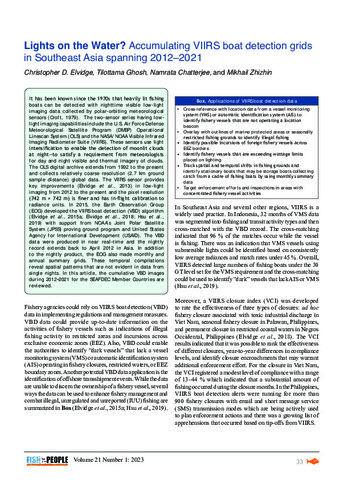အရာများအတွက် ရိုးရှင်းသော မှတ်တမ်းများကို ပြပါ။
Lights on the Water? Accumulating VIIRS boat detection grids in Southeast Asia spanning 2012–2021
Share
| dc.contributor.author | Elvidge, Christopher D. | |
| dc.contributor.author | Ghosh, Tilottama | |
| dc.contributor.author | Chatterjee, Namrata | |
| dc.contributor.author | Zhizhin, Mikhail | |
| dc.coverage.spatial | Southeast Asia | en |
| dc.date.accessioned | 2023-07-21T01:56:48Z | |
| dc.date.available | 2023-07-21T01:56:48Z | |
| dc.date.issued | 2023-07 | |
| dc.identifier.uri | http://hdl.handle.net/20.500.12066/7351 | |
| dc.description.abstract | It has been known since the 1970s that heavily lit fishing boats can be detected with nighttime visible low-light imaging data collected by polar-orbiting meteorological sensors (Croft, 1979). The two-sensor series having lowlight imaging capabilities include the U.S. Air Force Defense Meteorological Satellite Program (DMSP) Operational Linescan System (OLS) and the NASA/NOAA Visible Infrared Imaging Radiometer Suite (VIIRS). These sensors use light intensification to enable the detection of moonlit clouds at night—to satisfy a requirement from meteorologists for day and night visible and thermal imagery of clouds. The OLS digital archive extends from 1992 to the present and collects relatively coarse resolution (2.7 km ground sample distance) global data. The VIIRS sensor provides key improvements (Elvidge et al., 2013) in low-light imaging from 2012 to the present and the pixel resolution (742 m × 742 m) is finer and has in-flight calibration to radiance units. In 2015, the Earth Observation Group (EOG) developed the VIIRS boat detection (VBD) algorithm (Elvidge et al., 2015a; Elvidge et al., 2018; Hsu et al., 2019) with support from NOAA’s Joint Polar Satellite System (JPSS) proving ground program and United States Agency for International Development (USAID). The VBD data were produced in near real-time and the nightly record extends back to April 2012 in Asia. In addition to the nightly product, the EOG also made monthly and annual summary grids. These temporal compilations reveal spatial patterns that are not evident in data from single nights. In this article, the cumulative VBD images during 2012–2021 for the SEAFDEC Member Countries are reviewed. | en |
| dc.language.iso | en | en |
| dc.publisher | Secretariat, Southeast Asian Fisheries Development Center | en |
| dc.subject | Visible Infrared Imaging Radiometer Suite (VIIRS) | en |
| dc.title | Lights on the Water? Accumulating VIIRS boat detection grids in Southeast Asia spanning 2012–2021 | en |
| dc.type | magazineArticle | en |
| dc.citation.volume | 21 | |
| dc.citation.issue | 1 | |
| dc.citation.spage | 33 | en |
| dc.citation.epage | 38 | |
| dc.citation.journalTitle | Fish for the People | |
| dc.subject.asfa | fishing vessels | en |
| dc.subject.asfa | light | en |
| dc.subject.asfa | monitoring systems | en |
| dc.subject.asfa | detection | |
| dc.subject.asfa | boats |

